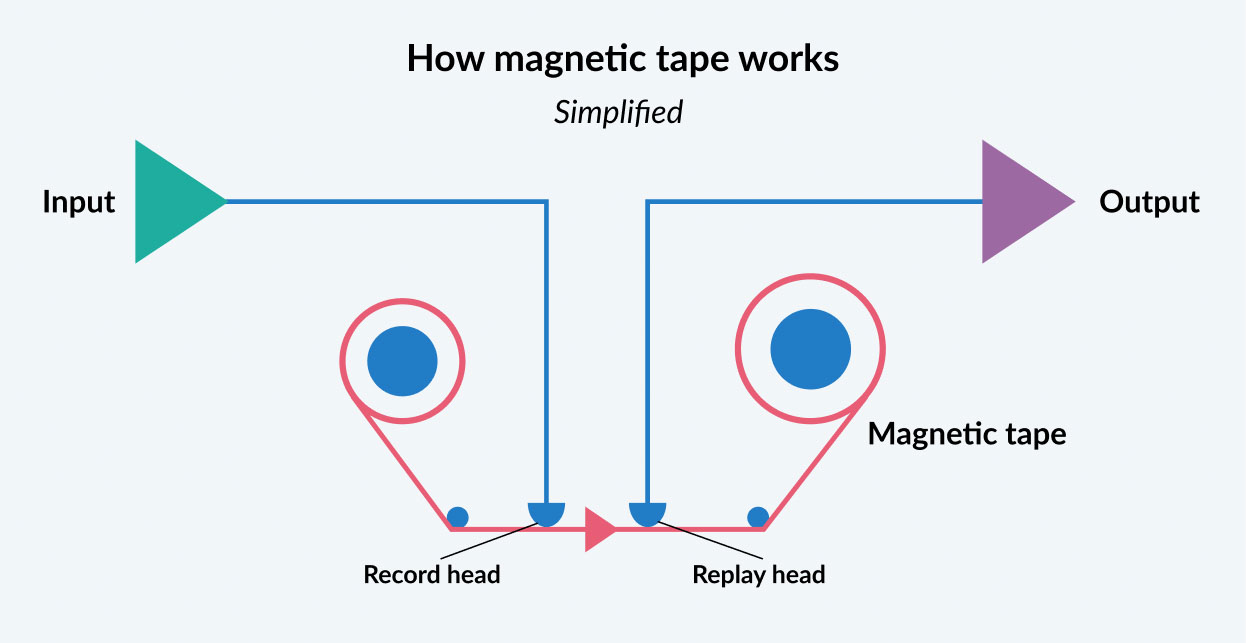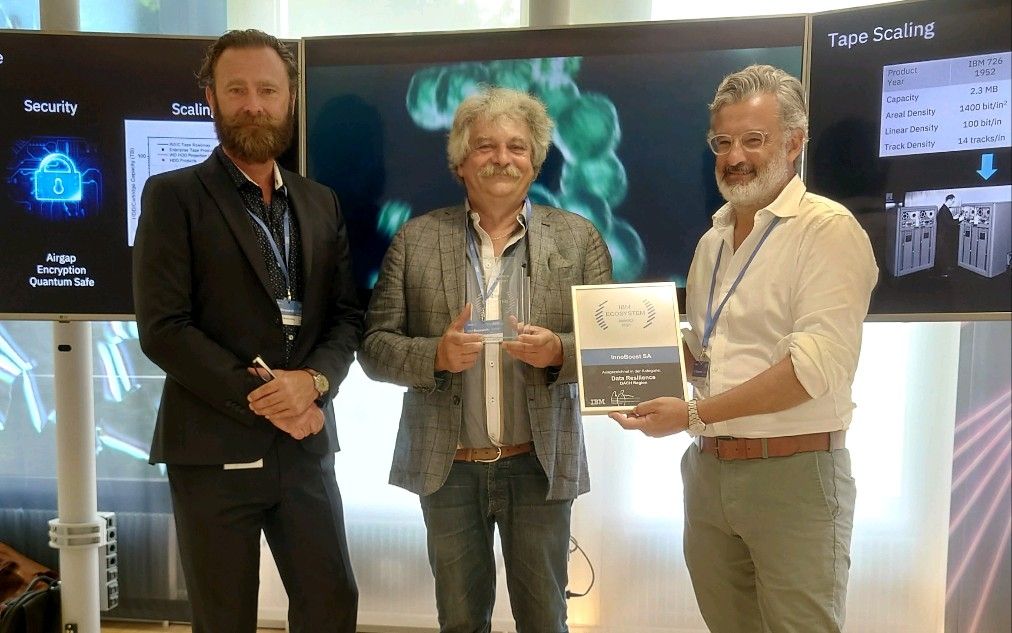Why is Magnetic Tape (Still) the Most Secure and Cost-effective Data Storage Solution?
7 min read
Summary
Magnetic tapes have been around for over 60 years and are still widely used today. Despite the advent of newer technologies, magnetic tape is still the most secure and cost-effective data storage solution. Its durability and compatibility with a wide range of devices make it an attractive option. Although tape has been around for a long time, it is becoming increasingly popular as cloud storage grows in popularity and businesses want to access their data as efficiently as possible. In the face of exponential data growth, we are exploring the intricacies of tape and its position as the most cost-effective, flexible, fastest, and secure backup solution.
Data continues to grow
Global data is expected to reach 175 zettabytes by 2025, a 61 percent annual growth rate. But where will all this data be stored? The first magnetic tape storage device, the IBM 726 Tape Unit, was introduced on May 21, 1952. Decades later, it’s almost unbelievable that the technology that can handle the enormous growth of digital data, protect it from cybercrime attacks, and archive data for some of the world’s largest data centers is more than 60 years old! But it is, and magnetic tape has no plans to stop anytime soon.
How it works and where it is used
Magnetic tape is widely used for data storage, especially in audio and video formats. The tapes are composed of a thin layer of magnetic material, usually iron oxide, applied to a flexible backing. The tapes are wound onto spools and stored in protective cases.
The data is stored in the form of tiny magnetic particles attracted to the coating on the tape. When the tape is played, a read head moves over the surface of the tape and picks up the magnetic particles. The head then converts the data into an electrical signal that a computer or other device can read.

1. Capacity: Magnetic tape can store a lot of data in a small space. This makes it ideal for long-term storage and archiving.
2. Security: Because data is stored offline in a tape library, it cannot fall victim to network-based cyber attacks.
3. Cost: Tape is inexpensive (per TB) compared to other storage options like hard drives and SSDs.
4. Reliability: Magnetic tape is very reliable (up to five orders of magnitude more reliable than an HDD), with a long shelf life and low error rates. It can last decades without degrading and is not susceptible to corruption like other storage methods.
5. Compatibility: Tape is compatible with various devices and operating systems, making it a versatile option for data storage.
6. Energy efficiency: It requires the least energy to store data from all other options like hard drives, which makes it more environmental friendly than those other storage technologies.
On the other hand, there are certain particularities when using tape:
-
- Special hardware and software are required to access the data stored on the tape.
- Physical damage can make the data on the tape inaccessible.
- Sensitivity to humidity and temperature can lead to data loss.
- While the streaming transfer speed per drive can reach hundreds of MB/s, the access time needed to locate data on the catridge is in multiples of tens of seconds.
Where do we go from there?
The future of tape looks bright, with no signs of slowing down in the development and innovation of this technology. With the ever-increasing demand for data storage, companies are looking for ways to store more information on tape while making it more durable and reliable.
One way to do this is to increase the capacity of tapes and the speed at which users can read them. This makes them ideal for archiving large amounts of data that must be kept for long periods. Another focus is to improve the tape resistance to physical damage and environmental influences. For example, some manufacturers now use a special coating that protects the tapes from water and other liquids.
IBM has developed tape solutions to mitigate the drawbacks of tape while maximizing their benefits. Newer tape technologies from IBM offer significantly higher storage density than previous generations and thus help reduce the cost of storing large amounts of data.
IBM tape drives and libraries provide multiple layers of data protection, while IBM Spectrum Archive offers solutions that make accessing data on tape as easy and fast as on disk.1
The latest LTO generation does wonders
The specifications of LTO (for Linear Tape Open) generation 9 – the latest generation announced by the LTO Consortium – include already-introduced features such as multi-layer security through hardware-based encryption, WORM (write once, read many) functionality, support for the Linear Tape File System (LTFS) protocol and backwards compatibility for read and write.
For that 9th generation, the LTO Consortium decided to balance costs and benefits of the technology within the specification and offer an 18 TB tape cartridge. This increases storage density by 50% over the previous generation. And with each subsequent generation, capacity will double.2 LTO-9 tape drives also offer about 11% higher transfer rates (400 MB/s) and 24% better average search time (45 s).
Enterprise tape brings even more advantages
The LTO Consortium releases a new generation of tape technologies approximately every 2.5 years, and when this happens, both the drive and tape cartridge change. Since LTO-8, a generation N drive can read and write generation N-1 cartridges (previously, it could read up to generation N-2 cartridges), which provides some investment protection and time to migrate to newer generations, but the performance (bandwidth, access time, search time, etc.) will be the same as if it was used in a generation N-1 drive.
In parallel to the LTO technology, IBM has developed its own proprietary tape technology called simply “Enterprise” (aka “Jaguar”), which does not only provide more native capacity, better performance and reliability, and more features, but also provides the best investment protection through the concept of “up-formatting”.
Indeed, with that technology, a generation N drive can not only read and write up to generation N-2 (sometimes even N-3) cartridges, but it can reformat them to provide better capacity and performance than the initial format. This allows customers to keep the same cartridges for a decade, while still increasing capacity and performance with each generation. When you factor in the fact that media can represent up to 90% percent of the total cost of a tape infrastructure for any mid-size to large installation, you realize the huge cost reduction that this technology provides, while making it quite environmentally friendly – saving tons of plastic and metals from the waste bin.

Can it work in a cloud setting?
Public cloud solutions offer many advantages for today’s businesses, but none outweigh the benefits of storing data offline with tape. Tape is the best way for enterprises to ensure security. With the increasing threat of cyber attacks and the increased importance of data protection, it is reasonable to combine tape storage with cloud storage. The two solutions can work together to store data effectively, access it quickly, and reduce storage costs while protecting data safely. (Find out more about cloud storage here and here.) By the way, most cloud providers today provide tape-based storage for their archiving or other “cold storage” solutions.
Tape is not dead; It Is here to stay
In conclusion, as Eric Bassier from Quantum would say, “Ultimately, tape is no longer about offsite storage; it’s about offline storage. Protecting data against ransomware and other malware attacks requires offline data protection. And tape is the most effective and cost-efficient method of providing it. If storage needs have mutated in recent years, tape’s role has changed rather than disappeared. As an offline medium, it still offers the best protection against emerging forms of cybersecurity threats and can be perfectly adapted to long-term storage needs, helping businesses now and in the years to come.”3
Michel Roethlisberger, CEO InnoBoost
“For the next decade, tape technology promises to be the most economical way to store data while providing an added security against malicious attacks because of the air gap that is inherent to its use.”
IBM is the number one tape storage vendor globally, with more than 65 years of commitment to technology in every industry. With continued innovation in its tape cartridges, drives and libraries, these systems provide robust and highly cost-effective solutions to the data storage challenges of today and tomorrow.4
Jeff Maslovsky, Partner Manager IBM Storage
“Two of the most powerful forces driving Information Technology today are the explosion of data volumes and the escalation of cyber security threats. Tape remains a leading solution in addressing modern data storage needs, supremely effective and offers some of the best ways to mitigate and even prevent cyber threats. InnoBoost can provide its customers with resilient solutions for their data.”
InnoBoost is at the forefront of tape storage
InnoBoost is an IBM Platinum Business Partner, a level reserved for partners who deliver high-value transformative solutions and achieve the highest levels of customer satisfaction, technical and sales certifications, and sales success.

At InnoBoost, we have proven experience working with the biggest and best customers to optimize data management. That is why, as part of InnoBoost’s comprehensive data lifecycle expertise, we offer a unique service to help our customers get maximum cost efficiency, flexibility, speed, and security out of their tape infrastructure.
For example, we have been working for more than 15 years with CERN, which were for a long period of time the largest IBM tape infrastructure in Europe, storing now around 500 petabytes of data from the LHC experiments. Be confident that we can meet all your data storage needs. Get early access and contact us today!
1 “IBM Storage Solution Brief: IBM tape solutions provide modern and powerful data protection”, 2021.
2“IBM Storage Solution Brief: Ninth Generation Cyber Resilient Tape Storage for your hybrid cloud”, 2021.
3“The enduring role of tape in the storage industry: moving from offsite to offline storage”, 2018.
4“IBM Storage Solution Brief: IBM tape solutions provide modern and powerful data protection”, 2021.
You may also like…
Unlocking the Power of Custom AI with InstructLab
5 min readSummary In the dynamic landscape of artificial intelligence, the ability to create models tailored to unique business needs is more than a competitive edge—it's a necessity. InstructLab, a collaborative initiative from IBM and Red Hat, is revolutionizing AI...
Strengthening Authentication in the Digital Age with IBM Verify
5 min readSummary In today’s interconnected world, the importance of robust authentication systems cannot be overstated. As digitalization accelerates, safeguarding sensitive data and critical systems has become a top priority for businesses. Effective access...
From Data Chaos to Data Confidence: Real-World Use Cases of IBM Data Product Hub
5 min readSummary In a world where data streams in from every direction—transactions, patient records, supply chain logs, and more—businesses often face “data chaos.” Instead of powering innovation, their data sits scattered in different formats and systems, making it...



